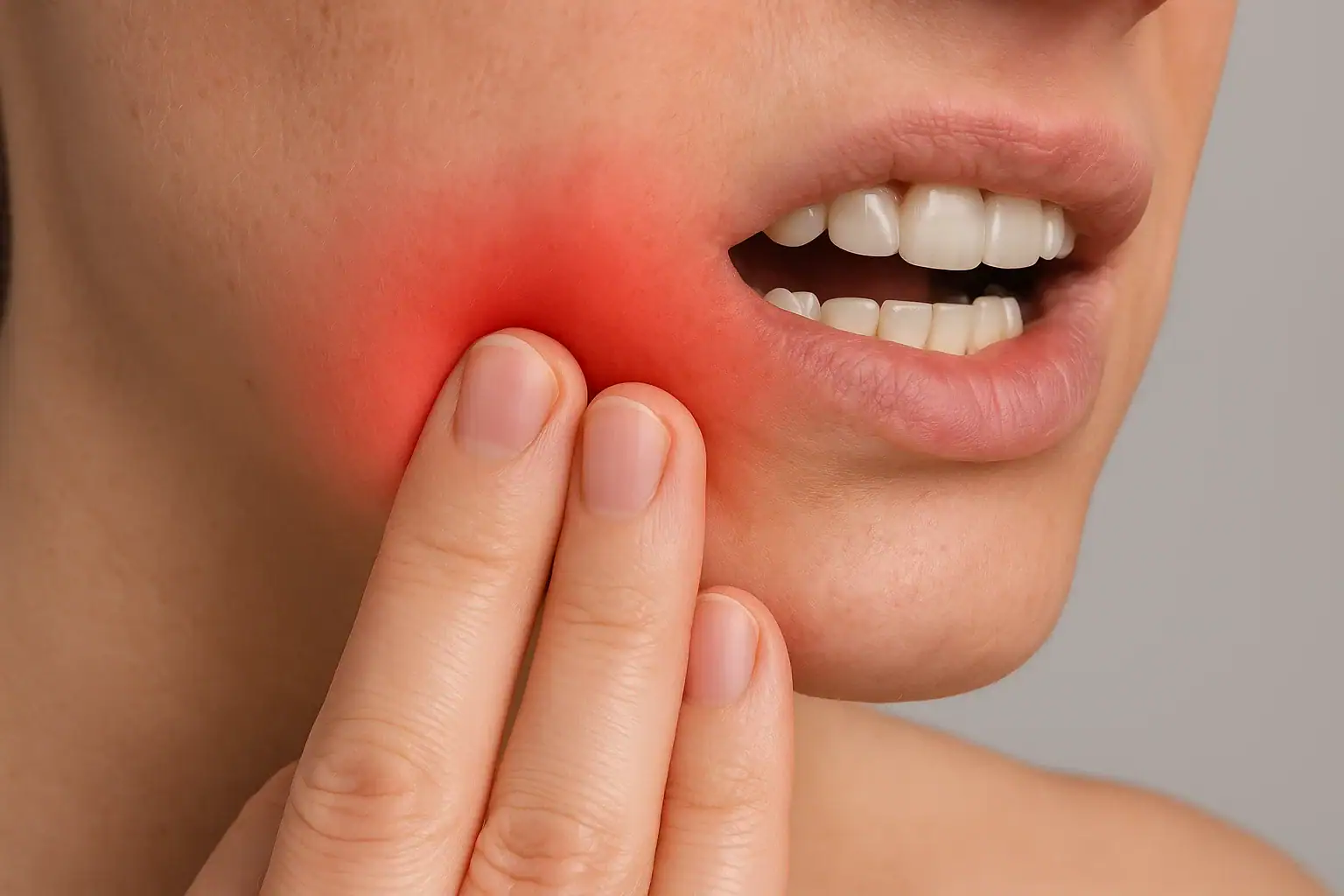Introduction: What Is an Impacted Tooth?
An impacted tooth is a tooth that fails to erupt properly into the dental arch within the expected time frame, often due to a physical obstruction like bone, soft tissue, or neighboring teeth. It can remain fully trapped (fully impacted) or only partially emerge (partially impacted), leading to pain, infection, or damage to adjacent teeth.
While impacted wisdom teeth (third molars) are the most commonly affected, impacted canine teeth also pose serious orthodontic and functional concerns.
Types of Impacted Teeth
1. Impacted Wisdom Teeth
Also known as third molars, these teeth erupt late (typically between ages 17–25). Due to limited space at the back of the mouth, they often remain impacted, causing pain, inflammation, or infections like pericoronitis.
2. Impacted Canine Teeth
The canine tooth, especially in the upper jaw, plays a critical role in bite alignment and aesthetics. Impaction is common during adolescence and often requires orthodontic intervention.
3. Other Impacted Teeth
Though less common, premolars and second molars can also become impacted, particularly in overcrowded arches or in patients with delayed tooth eruption.
What Causes an Impacted Tooth?
Common causes include:
- Lack of jaw space
- Overcrowding or malocclusion
- Abnormal tooth angle or rotation
- Genetic predisposition
- Delayed loss of baby teeth
- Jaw trauma or developmental issues
- Obstruction by cysts or tumors
What Are the Symptoms of an Impacted Tooth?
An impacted tooth can remain asymptomatic or cause the following signs:
- Swollen, red, or bleeding gums
- Persistent jaw pain or pressure
- Difficulty opening the mouth (trismus)
- Foul breath or bad taste
- Headaches or earaches
- Shifting or crowding of adjacent teeth
- Cyst formation or infection
Impacted wisdom tooth symptoms often include jaw stiffness, swelling in the lower face, and pain radiating to the ear or neck.
Can an Impacted Wisdom Tooth Cause Neck Pain?
Yes. An impacted wisdom tooth can cause referred pain that extends to the jaw, ear, head, and neck. The inflammation or infection may spread and irritate surrounding nerves, leading to discomfort beyond the oral cavity.
What Does an Impacted Wisdom Tooth Look Like?
On a panoramic X-ray or CBCT scan, an impacted wisdom tooth may appear:
- Horizontally or diagonally positioned
- Pressed against the adjacent molar
- Trapped below the gum or jawbone
- Surrounded by a fluid-filled dentigerous cyst
Classification of Tooth Impaction
Impacted teeth are classified based on their angulation and eruption pattern:
- Mesial Impaction: Tooth tilts forward
- Distal Impaction: Tooth tilts backward
- Vertical Impaction: Tooth is in a normal orientation but fails to erupt
- Horizontal Impaction: Tooth lies flat and presses against others
- Soft Tissue Impaction: Covered by gums but not bone
- Bony Impaction: Completely enclosed in bone
Diagnosis: How Dentists Identify an Impacted Tooth
- Clinical Examination: Visual inspection for swelling, tenderness, or eruption delay.
- Panoramic X-ray or CBCT: To assess exact location and angle.
- 3D Imaging: Helps assess root structure and relation to nerves or sinuses.
Associated Risks & Complications
If left untreated, an impacted tooth can lead to:
- Infection (pericoronitis)
- Tooth decay on adjacent teeth
- Periodontal disease
- Cyst or tumor formation
- Root resorption of nearby teeth
- Malocclusion (bite misalignment)
- Chronic sinus issues (if in the upper jaw)
Impacted Tooth and Oral Pathology
A neglected impacted tooth may trigger:
- Dentigerous cyst: A fluid-filled sac around the crown of the impacted tooth
- Odontogenic tumors: Rare but possible
- Resorption of adjacent roots
- Loss of surrounding bone
Early detection through imaging is crucial to prevent these outcomes.
Treatment Options for Impacted Teeth
1. Observation
Asymptomatic impacted teeth may be monitored regularly through dental checkups and imaging.
2. Surgical Extraction
Wisdom teeth and severely impacted teeth are often surgically removed.
Procedure includes:
- Local or general anesthesia
- Gum flap incision
- Bone removal if needed
- Tooth sectioning and extraction
- Suturing
Healing typically takes 7–10 days, but full bone healing may take months.
3. Orthodontic Exposure & Traction
In impacted canine tooth cases, orthodontists may surgically expose the tooth and guide it into place using braces.
4. Pain & Infection Management
- Antibiotics for infection
- Anti-inflammatory medications
- Warm saltwater rinses
- Soft diet recommendations
Recovery After Tooth Impaction Surgery
Timeline
- Day 1–2: Swelling, minor bleeding, and discomfort
- Day 3–4: Peak inflammation
- Day 7: Suture removal (if non-dissolvable)
- 2–3 weeks: Gum healing
- 3–6 months: Complete bone healing
Aftercare Tips
- Apply ice for the first 24 hours
- Avoid smoking, alcohol, or using straws
- Sleep with head elevated
- Eat soft, lukewarm food (soups, smoothies, yogurt)
- Rinse gently with warm saltwater
Avoid hard, crunchy, spicy, or hot foods for at least a week.
Prevention: Can Impacted Teeth Be Avoided?
Although genetics plays a major role, you can reduce the risk through:
- Regular dental check-ups
- Early orthodontic evaluations (by age 7)
- Early imaging (especially for wisdom teeth)
- Timely removal of baby teeth
When Should You See a Dentist?
You should consult a dentist if you experience:
- Jaw or gum pain
- Persistent swelling
- Pus discharge or bad breath
- Difficulty chewing or opening your mouth
- Recurrent sinus infections
- Misalignment or shifting of other teeth
Who Treats Impacted Teeth?
- Oral and Maxillofacial Surgeons: Perform surgical extractions
- Orthodontists: Handle canine impactions and alignment issues
- General Dentists: Monitor and refer when necessary
Impacted Teeth in Children & Adolescents
- Commonly affects canines
- May delay proper bite development
- Early detection allows for less invasive correction
American Association of Orthodontists recommends an orthodontic screening by age 7.
Global Prevalence and Insights
- Over 70% of people have at least one impacted third molar
- Females are more commonly affected due to smaller jaw size
- East Asian populations show higher impaction rates due to jaw structure
Patient Stories & Visual Content Ideas (for Blogs/Social)
- X-ray image comparison: before and after surgery
- "My Impacted Tooth Surgery Journey" – Testimonial video
- Step-by-step recovery time-lapse reels
- Interactive infographic: Types of impaction
Frequently Asked Questions (FAQs)
What is an impacted tooth?
An impacted tooth is one that does not erupt fully due to a blockage in the jaw or gum tissue.
What is an impacted wisdom tooth?
A third molar that fails to fully emerge, often causing swelling, infection, or pain in the back of the mouth.
What does an impacted wisdom tooth look like?
It may appear tilted, horizontal, or submerged in the bone when viewed on a dental X-ray.
Can an impacted wisdom tooth cause neck pain?
Yes, especially when surrounding tissues or nerves are inflamed, the pain can radiate to the neck or head.
What are the symptoms of an impacted wisdom tooth?
- Gum swelling
- Jaw stiffness
- Ear or neck pain
- Foul breath
- Crowding of nearby teeth
Conclusion: Don’t Let an Impacted Tooth Go Untreated
An impacted tooth can silently cause damage long before symptoms appear. Whether it's a wisdom tooth, canine, or another type, early diagnosis and timely treatment are crucial. Consult a dental professional to determine the best course of action—and regain control of your oral health before complications arise.

